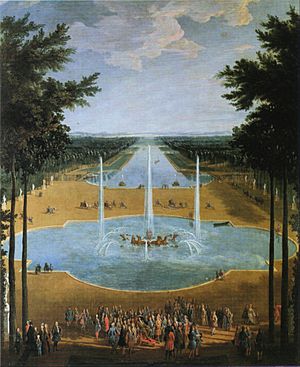Fountain of Apollo facts for kids
The Fountain of Apollo (French: Bassin d'Apollon) is a beautiful fountain at the famous Palace of Versailles in France. It shows the Greek sun god Apollo as he rises from the sea at dawn. He is in his special four-horse chariot, with Tritons (sea gods) by his side.
This fountain is a key part of the amazing gardens at Versailles. It connects to the Grand Canal, a large body of water in the palace grounds.
Contents
History of the Fountain
Before the fountain was built, there was a pond here. In 1639, King Louis XIII had this pond dug. It was known as the Pond of the Swans.
Later, in 1671, his son, King Louis XIV, made the pond much bigger. Louis XIV was also known as the "Sun King." This is why the artist Charles Le Brun suggested dedicating the fountain to Apollo, the sun god. It was a way to connect the king with the powerful sun.
The gilded (gold-covered) statue of Apollo was created by the artist Jean-Baptiste Tuby from Rome. It was put in place in 1671.
Apollo's Journey
The fountain shows Apollo leaving the grotto of Thetys, where he spent the night. He is ready to begin his daily journey across the sky in his chariot. This idea of Apollo's journey was a popular theme in art during that time.
Interestingly, the Fountain of Apollo at Versailles shows Apollo rising in the west. This is not correct, as the sun always rises in the east.
A Replica in Taiwan
In 2014, a full-size copy of the Fountain of Apollo was opened in Tainan, Taiwan. It stands at the entrance of the Chimei Museum.
The museum asked French artist Gills Perrault in 2008 to make this exact copy. It took three years to use modern laser tools to measure the original and create a mold in France. Then, it took another three years to carve the marble in Italy.
Unlike the original in Versailles, the Fountain of Apollo at the Chimei Museum correctly shows Apollo rising from the east.
Related Pages
Gallery
See also
 In Spanish: Estanque de Apolo para niños
In Spanish: Estanque de Apolo para niños









